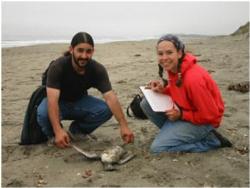Welcome to our ongoing effort to catalog citizen science and other public participation in scientific research (PPSR) projects for UC California Naturalists and other citizen scientists. We invite you to browse the listed projects or enter key words (like birds, youth, invasive, coast, Alameda, etc.) in the search box above to find projects in your area. It's a great way to stay involved and keep developing your skills as a natural scientist!
A vast majority of the information in the database was gathered from project websites and may be out of date. We encourage you to contact projects directly to get involved and learn about most recent opportunities. If you work with a listed project and would like to add to, update, or correct the information we have, please email cghdixon@ucdavis.edu. Also, please consider filling out the "PPSR perspectives" survey. Click here to access the survey, which will help guide this project in the coming year.
If you know of a project not on our list, please go to the "tell us about a project" link on the left so we can list the project here. Thanks for your help!
Special thanks goes to the National Science Foundation Informal Science Education program and the Stephen J. Bechtel, Jr. Foundation for supporting this database of projects.
Beach COMBERS
-
Organization NameMonterey Bay National Marine Sanctuary
-
Project Website
-
Organization Website
-
PartnersCal State University Moss Landing Marine Laboratories
-
Contact NameHannah Nevins, Lisa Emanuelson
-
Contact Emailhnevins@mlml.calstate.edu, lisa.emanuelson@noaa.gov
-
Contact Phone(831) 647-4201
-
Other Contact Information
Beach COMBERS Monterey Bay National Marine Sanctuary 299 Foam Street Monterey, CA 93940
-
Project Purpose (taken from project materials)
1) obtain baseline information on rates of beach deposition of marine birds and mammals; 2) assess causes of seabird and marine mammal mortality; 3) assist resource management agencies in early detection of unusual rates of natural and anthropogenic mortality; 4) assess abundance of tar balls (oil patches) on beaches; 5) build a network of interacting citizens, scientists, and resource managers; and 6) disseminate information to the resource managers, public, and educational institutions
-
Participant Activities
Volunteers are assigned to a particular beach, returning at the same time each month to record the changes they observe throughout the year.
-
Data Entry
-
Unknown
-
-
Other Participant ActivitiesN / A
-
System Studied
-
Mammals
-
Birds
-
Marine
-
Other (see Notes)
-
-
Geographic ScopeRegional
-
RegionNorthern California
-
LocationBeaches in and around Monterrey Bay
-
Location - Map299 Foam Street, Monterey, CA
-
Time Commitment
-
Monthly
-
-
Volunteer Qualifications
Volunteers must be willing and able to walk long stretches of sandy, uneven terrain, often remote from human services.
-
Volunteer Training
Volunteers receive 20 hours of training on how to survey a beach, identify marine birds and mammals, and document observations
-
Cost to Participant
None described
-
How will the findings be used?
The website and brochure report past successes as including:
•Discovery of banded birds from as far away as Hawaii;
• Comparisons between Monterey Bay and Gulf of the Farallones National Marine Sanctuaries, revealing unusually high numbers of dead adult harbor seals in localized areas;
• High deposition of Common Murres led to the discovery of a previously unrecognized threat of gillnet mortality for Common Murres, Harbor Porpoise, and Sea Otters;
• Assessment of impacts from oil spills in Monterey Bay;
• Contribution to an article in Nature documenting the impacts of a toxic marine algal bloom on marine animals.
• 10 years of monitoring birds and mammals http://sanctuaries.noaa.gov/science/conservation/beachcomber.html
-
Other Information
Beach segments are approximately 5 km in length and surveys take an average of 4 hours to complete. Volunteer pairs return each month to make observations.
Beach COMBERS volunteers work in pairsFor projects in the SIMoN network: http://www.sanctuarysimon.org/monterey/sections/beachCombers/index.php
-
Photo

-
last update:N / A
If you work with this project and would like to add to or update the information below, please email cghdixon@ucdavis.edu.
If you know of a project not on our list, please go to the "tell us about a project" link on the left so we can list the project here. Thanks for your help!
This database is focused on projects in California focused on the environment. For opportunities outside California, as well as national projects that don't have a California-specific components, check http://www.birds.cornell.edu/citscitoolkit/projects.

